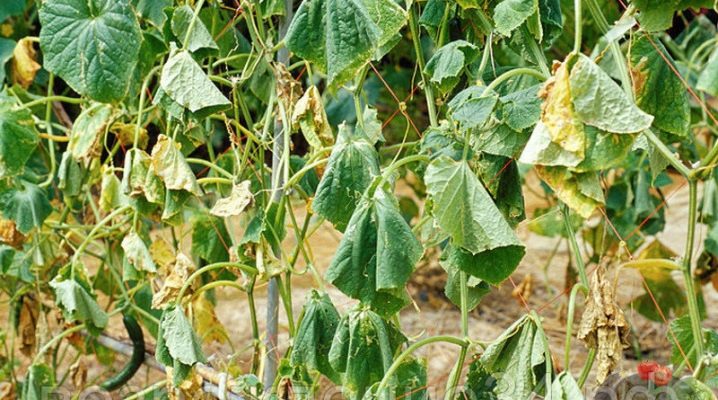All about fusarium cucumber wilting

Cucumbers, like any other plants grown in the beds, can be subject to various infectious diseases. One of the most common diseases that pose a danger to this crop is fusarium wilting.

Description
Fusarium is a disease caused by the Fusarium fungus. The disease affects cucumbers growing both in the greenhouse and in the open field. Infection with this disease can occur through water, infected seed or contaminated soil. The following factors contribute to its development:
- a sharp change in temperature;
- high humidity;
- lack of sunlight;
- prolonged cold snap;
- mechanical damage to the roots;
- high acidity of the soil.
The disease develops very quickly. But at the initial stages it is very difficult to notice it.

When examining a site, a person should pay attention to the following symptoms of the disease.
- Darkening of the stem... The disease primarily affects the lower part of the bush. The root collar of the cucumber darkens and becomes covered with a dense bloom.
- Cracking shoots... As the disease spreads, the stems of the cucumber thin and crack. Over time, they dry out completely.
- Withering foliage... The leaves at the bottom of the bush wither first. They turn yellow, covered with brown spots of various sizes and curl. At this time, the plant already looks completely sick.
- Falling ovaries. If an adult plant is sick, flowers and ovaries begin to crumble from it. Fruits on such bushes either do not appear at all, or appear in small quantities. If the disease affects a fruiting plant, the cucumbers growing on it become deformed and have a bitter taste.
Having noticed these signs, the gardener needs to immediately start fighting fusarium. Otherwise, the plants will die and the person will be left without a crop.

It is quite difficult to deal with fusarium wilting. Gardeners do it in all available ways.
Chemicals
To quickly save cucumbers, gardeners prefer to treat the beds with chemicals. The most popular are the following.
- Fundazol. This chemical is used to treat the area twice. The interval between procedures should be within 20 days. The last time the bushes need to be sprayed no later than a month before harvest.
- Topsin-M... It is one of the most effective fungicides available. It can be used to treat both young seedlings and mature bushes. After spraying the plants with this preparation, they are protected by the active ingredient for another two weeks.
- "Humisol". This drug is used to prevent fusarium. They process planting material and seedlings.


You need to use these funds, following the instructions on the package. Before using the gardener, be sure to wear protective clothing, gloves and a mask.
Biologicals
Suitable for processing cucumbers and various biological preparations. It is recommended to treat adult plants with Fitosporin. Seedlings can be sprayed with a preparation called Vitaros.


All products for the fight against fusarium are sold in sealed containers. You can find them at most gardening stores. Use of biological products, like chemicals, must be according to the instructions.
They can be used not only in case of plant infection, but also to prevent it. Some gardeners prefer to spray cucumbers throughout the growing season with an interval of 2-3 weeks.

Folk remedies
Many gardeners prefer to treat cucumbers with folk remedies. The following products can be used to treat the site.
- Wood ash. Gardeners use dry ash to fight many diseases. For the treatment of fusarium, a solution is prepared consisting of 200 grams of ash and two tablespoons of liquid soap. This mixture is diluted in a liter of warm water. The product is used to treat plants immediately.
- Onion peel. The collected dry husk is placed in a saucepan and poured over with water. The product is boiled for half an hour. After that, the liquid is filtered. The solution is used to spray plants. The procedure should be repeated 3-4 times in a row with a break of several days. The remaining husk can be sent to a compost pit or embedded in the soil. It will be an excellent fertilizer for most plants.
- Milk... A mixture of milk and iodine is used to treat the bushes. A small amount of iodine and 70-100 grams of soap are added to a glass of dairy products. All this is thoroughly mixed. The resulting mixture is carefully treated with shoots and lower foliage. This is most conveniently done with a small brush. You can also use whey instead of milk.
- Garlic... A small amount of garlic is finely chopped and placed in a container of water. A remedy for combating fusarium is infused during the day. After that, it must be diluted in a bucket of water and used to spray infected bushes. A product with such a pungent odor is also excellent at repelling many pests.


Folk remedies are used to treat only those plants that are not yet too infected. In other cases, they will not help. If the plants have been infected and the cucumbers cannot be saved, they must be removed from the site. To destroy the fungus, it is recommended to burn the plant residues.
Prevention measures
In order not to waste time on the treatment of fusarium, the gardener should remember about certain preventive measures.
- Observe the crop rotation... Seedlings should not be planted in areas where cucumbers previously grew. If there were previously plants suffering from fusarium on the site, you should not plant cucumbers there for another 3-4 years. After all, the fungus that provokes the development of the disease persists in the soil for a long time. To cleanse the area of toxins, the gardener should sow green manures, for example, white mustard, in the beds.
- Disinfect seeds before planting. This can be done in any way possible. Most often, a weak solution of potassium permanganate is used for this purpose.
- Disinfect tools... This should be done both when transplanting plants and when pruning stems. Before planting cucumbers in greenhouses, the room also needs to be processed. For this, it is best to use copper sulfate.
- Apply fertilizers to the soil. You need to feed the plants on a regular basis. This will not only help to improve the yield of the bushes, but also make the cucumbers stronger. Therefore, it will be easier for them to resist fusarium and other diseases. If the soil on the site is acidic, in the fall, wood ash should be embedded in the ground.
- Plant only healthy seedlings. Weak seedlings must be destroyed. When transplanting seedlings to a garden bed, it is advisable to spill the soil with boiling water or disinfect it with a solution of potassium permanganate.
- Destroy all weeds. Cucumbers growing in neglected beds get sick much more often. Therefore, all weeds must be removed regularly. The soil must be loosened in the process. This should be done very carefully so as not to injure the plants.
- Watering the beds... Use warm water for irrigation. It is worth carrying out this procedure after sunset. In this case, you should not flood the plants. This will lead to decay of plant roots.
- Get rid of plant residues after harvest. Tops, roots and various debris must be destroyed, and the soil must be disinfected.



If you properly care for the site and the cucumbers growing on it, the gardener will not have to deal with most of the diseases that pose a danger to this culture.
Resistant varieties
There are no varieties of cucumbers completely resistant to fusarium. But there are some plants that get sick much less often.
- "Noble"... This is an early maturing hybrid that can be grown both outdoors and indoors. Such cucumbers grow even in conditions that are not very suitable for this culture. Their fruits are very tasty. They are ideal for pickling and preparing salads.
- Ryabinushka. This variety is also hybrid. It is usually chosen for growing in greenhouses. The plant has large smooth leaves. Its fruits are even and large. They are great for preservation.
- "Hector". Self-pollinating hybrid has a short ripening period. The plant is unpretentious to temperature extremes and is not afraid of high humidity. This variety of cucumbers can be planted by those who plan to sell the fruit.
- "Kristina". An early ripe hybrid bears excellent fruit. The fruits are suitable for pickling. As a rule, they are picked very small. Harvesting can be done every two days. You can grow such cucumbers both in the beds and in the greenhouse.
- "Dunyasha". This type of cucumber is ideal for growing in cold regions. Plants are resistant to viral and fungal diseases. They bear fruit well. Therefore, the crop is consumed fresh and used for salting.
- Zhukovsky. The hybrid is resistant to fusarium and powdery mildew. Therefore, gardeners usually do not have problems with the cultivation of such cucumbers. The fruits are cylindrical in shape. Their surface is covered with small tubercles.
- "Knight". It is one of the most popular hybrid varieties. His yield is high. The plant is resistant not only to fusarium, but also to other diseases. You can grow crops both in the open field and in greenhouses.



Knowing all the features of this disease, the gardener may well save cucumbers from fusarium wilt.





The comment was sent successfully.